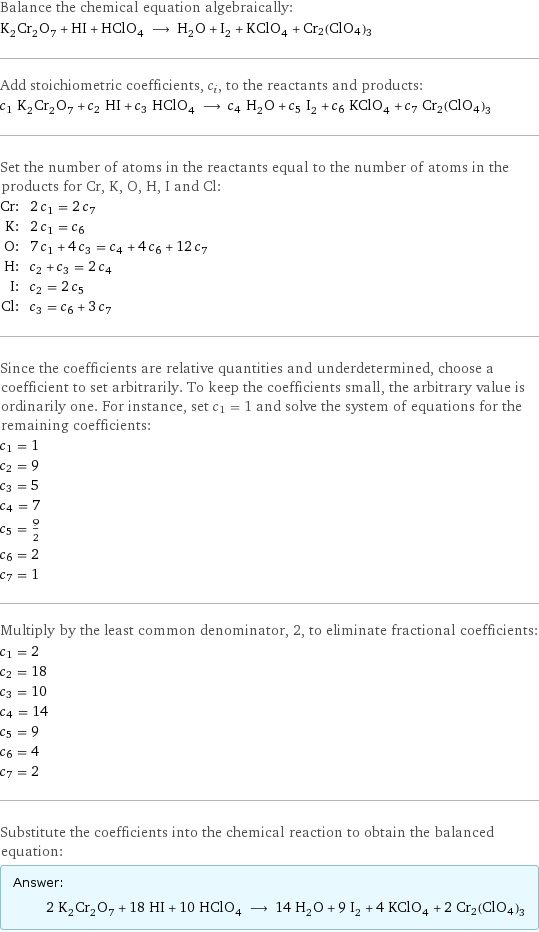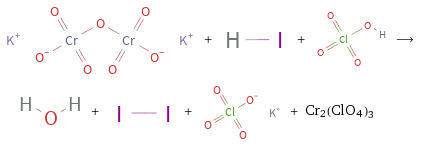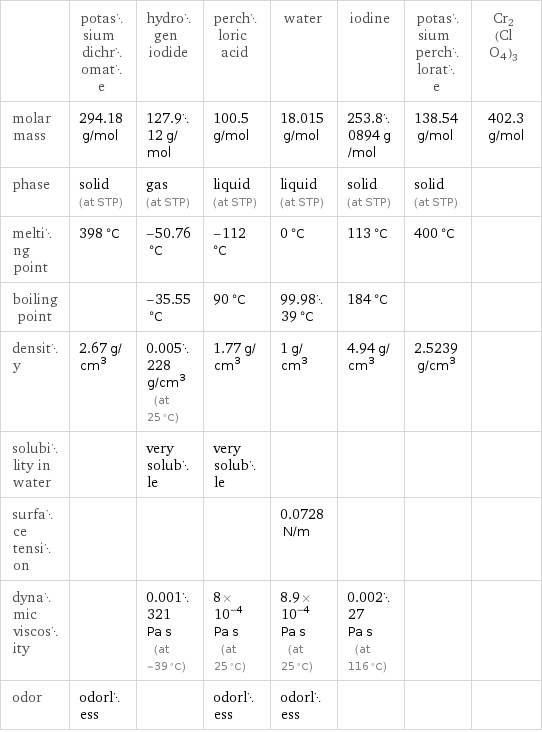Input interpretation

K_2Cr_2O_7 potassium dichromate + HI hydrogen iodide + HClO_4 perchloric acid ⟶ H_2O water + I_2 iodine + KClO_4 potassium perchlorate + Cr2(ClO4)3
Balanced equation

Balance the chemical equation algebraically: K_2Cr_2O_7 + HI + HClO_4 ⟶ H_2O + I_2 + KClO_4 + Cr2(ClO4)3 Add stoichiometric coefficients, c_i, to the reactants and products: c_1 K_2Cr_2O_7 + c_2 HI + c_3 HClO_4 ⟶ c_4 H_2O + c_5 I_2 + c_6 KClO_4 + c_7 Cr2(ClO4)3 Set the number of atoms in the reactants equal to the number of atoms in the products for Cr, K, O, H, I and Cl: Cr: | 2 c_1 = 2 c_7 K: | 2 c_1 = c_6 O: | 7 c_1 + 4 c_3 = c_4 + 4 c_6 + 12 c_7 H: | c_2 + c_3 = 2 c_4 I: | c_2 = 2 c_5 Cl: | c_3 = c_6 + 3 c_7 Since the coefficients are relative quantities and underdetermined, choose a coefficient to set arbitrarily. To keep the coefficients small, the arbitrary value is ordinarily one. For instance, set c_1 = 1 and solve the system of equations for the remaining coefficients: c_1 = 1 c_2 = 9 c_3 = 5 c_4 = 7 c_5 = 9/2 c_6 = 2 c_7 = 1 Multiply by the least common denominator, 2, to eliminate fractional coefficients: c_1 = 2 c_2 = 18 c_3 = 10 c_4 = 14 c_5 = 9 c_6 = 4 c_7 = 2 Substitute the coefficients into the chemical reaction to obtain the balanced equation: Answer: | | 2 K_2Cr_2O_7 + 18 HI + 10 HClO_4 ⟶ 14 H_2O + 9 I_2 + 4 KClO_4 + 2 Cr2(ClO4)3
Structures

+ + ⟶ + + + Cr2(ClO4)3
Names

potassium dichromate + hydrogen iodide + perchloric acid ⟶ water + iodine + potassium perchlorate + Cr2(ClO4)3
Equilibrium constant
![Construct the equilibrium constant, K, expression for: K_2Cr_2O_7 + HI + HClO_4 ⟶ H_2O + I_2 + KClO_4 + Cr2(ClO4)3 Plan: • Balance the chemical equation. • Determine the stoichiometric numbers. • Assemble the activity expression for each chemical species. • Use the activity expressions to build the equilibrium constant expression. Write the balanced chemical equation: 2 K_2Cr_2O_7 + 18 HI + 10 HClO_4 ⟶ 14 H_2O + 9 I_2 + 4 KClO_4 + 2 Cr2(ClO4)3 Assign stoichiometric numbers, ν_i, using the stoichiometric coefficients, c_i, from the balanced chemical equation in the following manner: ν_i = -c_i for reactants and ν_i = c_i for products: chemical species | c_i | ν_i K_2Cr_2O_7 | 2 | -2 HI | 18 | -18 HClO_4 | 10 | -10 H_2O | 14 | 14 I_2 | 9 | 9 KClO_4 | 4 | 4 Cr2(ClO4)3 | 2 | 2 Assemble the activity expressions accounting for the state of matter and ν_i: chemical species | c_i | ν_i | activity expression K_2Cr_2O_7 | 2 | -2 | ([K2Cr2O7])^(-2) HI | 18 | -18 | ([HI])^(-18) HClO_4 | 10 | -10 | ([HClO4])^(-10) H_2O | 14 | 14 | ([H2O])^14 I_2 | 9 | 9 | ([I2])^9 KClO_4 | 4 | 4 | ([KClO4])^4 Cr2(ClO4)3 | 2 | 2 | ([Cr2(ClO4)3])^2 The equilibrium constant symbol in the concentration basis is: K_c Mulitply the activity expressions to arrive at the K_c expression: Answer: | | K_c = ([K2Cr2O7])^(-2) ([HI])^(-18) ([HClO4])^(-10) ([H2O])^14 ([I2])^9 ([KClO4])^4 ([Cr2(ClO4)3])^2 = (([H2O])^14 ([I2])^9 ([KClO4])^4 ([Cr2(ClO4)3])^2)/(([K2Cr2O7])^2 ([HI])^18 ([HClO4])^10)](../image_source/4ed432d9f8e3a0ac1db2f010e33872c3.png)
Construct the equilibrium constant, K, expression for: K_2Cr_2O_7 + HI + HClO_4 ⟶ H_2O + I_2 + KClO_4 + Cr2(ClO4)3 Plan: • Balance the chemical equation. • Determine the stoichiometric numbers. • Assemble the activity expression for each chemical species. • Use the activity expressions to build the equilibrium constant expression. Write the balanced chemical equation: 2 K_2Cr_2O_7 + 18 HI + 10 HClO_4 ⟶ 14 H_2O + 9 I_2 + 4 KClO_4 + 2 Cr2(ClO4)3 Assign stoichiometric numbers, ν_i, using the stoichiometric coefficients, c_i, from the balanced chemical equation in the following manner: ν_i = -c_i for reactants and ν_i = c_i for products: chemical species | c_i | ν_i K_2Cr_2O_7 | 2 | -2 HI | 18 | -18 HClO_4 | 10 | -10 H_2O | 14 | 14 I_2 | 9 | 9 KClO_4 | 4 | 4 Cr2(ClO4)3 | 2 | 2 Assemble the activity expressions accounting for the state of matter and ν_i: chemical species | c_i | ν_i | activity expression K_2Cr_2O_7 | 2 | -2 | ([K2Cr2O7])^(-2) HI | 18 | -18 | ([HI])^(-18) HClO_4 | 10 | -10 | ([HClO4])^(-10) H_2O | 14 | 14 | ([H2O])^14 I_2 | 9 | 9 | ([I2])^9 KClO_4 | 4 | 4 | ([KClO4])^4 Cr2(ClO4)3 | 2 | 2 | ([Cr2(ClO4)3])^2 The equilibrium constant symbol in the concentration basis is: K_c Mulitply the activity expressions to arrive at the K_c expression: Answer: | | K_c = ([K2Cr2O7])^(-2) ([HI])^(-18) ([HClO4])^(-10) ([H2O])^14 ([I2])^9 ([KClO4])^4 ([Cr2(ClO4)3])^2 = (([H2O])^14 ([I2])^9 ([KClO4])^4 ([Cr2(ClO4)3])^2)/(([K2Cr2O7])^2 ([HI])^18 ([HClO4])^10)
Rate of reaction
![Construct the rate of reaction expression for: K_2Cr_2O_7 + HI + HClO_4 ⟶ H_2O + I_2 + KClO_4 + Cr2(ClO4)3 Plan: • Balance the chemical equation. • Determine the stoichiometric numbers. • Assemble the rate term for each chemical species. • Write the rate of reaction expression. Write the balanced chemical equation: 2 K_2Cr_2O_7 + 18 HI + 10 HClO_4 ⟶ 14 H_2O + 9 I_2 + 4 KClO_4 + 2 Cr2(ClO4)3 Assign stoichiometric numbers, ν_i, using the stoichiometric coefficients, c_i, from the balanced chemical equation in the following manner: ν_i = -c_i for reactants and ν_i = c_i for products: chemical species | c_i | ν_i K_2Cr_2O_7 | 2 | -2 HI | 18 | -18 HClO_4 | 10 | -10 H_2O | 14 | 14 I_2 | 9 | 9 KClO_4 | 4 | 4 Cr2(ClO4)3 | 2 | 2 The rate term for each chemical species, B_i, is 1/ν_i(Δ[B_i])/(Δt) where [B_i] is the amount concentration and t is time: chemical species | c_i | ν_i | rate term K_2Cr_2O_7 | 2 | -2 | -1/2 (Δ[K2Cr2O7])/(Δt) HI | 18 | -18 | -1/18 (Δ[HI])/(Δt) HClO_4 | 10 | -10 | -1/10 (Δ[HClO4])/(Δt) H_2O | 14 | 14 | 1/14 (Δ[H2O])/(Δt) I_2 | 9 | 9 | 1/9 (Δ[I2])/(Δt) KClO_4 | 4 | 4 | 1/4 (Δ[KClO4])/(Δt) Cr2(ClO4)3 | 2 | 2 | 1/2 (Δ[Cr2(ClO4)3])/(Δt) (for infinitesimal rate of change, replace Δ with d) Set the rate terms equal to each other to arrive at the rate expression: Answer: | | rate = -1/2 (Δ[K2Cr2O7])/(Δt) = -1/18 (Δ[HI])/(Δt) = -1/10 (Δ[HClO4])/(Δt) = 1/14 (Δ[H2O])/(Δt) = 1/9 (Δ[I2])/(Δt) = 1/4 (Δ[KClO4])/(Δt) = 1/2 (Δ[Cr2(ClO4)3])/(Δt) (assuming constant volume and no accumulation of intermediates or side products)](../image_source/130b87cd54c67ed3ec5e499e9c8c98da.png)
Construct the rate of reaction expression for: K_2Cr_2O_7 + HI + HClO_4 ⟶ H_2O + I_2 + KClO_4 + Cr2(ClO4)3 Plan: • Balance the chemical equation. • Determine the stoichiometric numbers. • Assemble the rate term for each chemical species. • Write the rate of reaction expression. Write the balanced chemical equation: 2 K_2Cr_2O_7 + 18 HI + 10 HClO_4 ⟶ 14 H_2O + 9 I_2 + 4 KClO_4 + 2 Cr2(ClO4)3 Assign stoichiometric numbers, ν_i, using the stoichiometric coefficients, c_i, from the balanced chemical equation in the following manner: ν_i = -c_i for reactants and ν_i = c_i for products: chemical species | c_i | ν_i K_2Cr_2O_7 | 2 | -2 HI | 18 | -18 HClO_4 | 10 | -10 H_2O | 14 | 14 I_2 | 9 | 9 KClO_4 | 4 | 4 Cr2(ClO4)3 | 2 | 2 The rate term for each chemical species, B_i, is 1/ν_i(Δ[B_i])/(Δt) where [B_i] is the amount concentration and t is time: chemical species | c_i | ν_i | rate term K_2Cr_2O_7 | 2 | -2 | -1/2 (Δ[K2Cr2O7])/(Δt) HI | 18 | -18 | -1/18 (Δ[HI])/(Δt) HClO_4 | 10 | -10 | -1/10 (Δ[HClO4])/(Δt) H_2O | 14 | 14 | 1/14 (Δ[H2O])/(Δt) I_2 | 9 | 9 | 1/9 (Δ[I2])/(Δt) KClO_4 | 4 | 4 | 1/4 (Δ[KClO4])/(Δt) Cr2(ClO4)3 | 2 | 2 | 1/2 (Δ[Cr2(ClO4)3])/(Δt) (for infinitesimal rate of change, replace Δ with d) Set the rate terms equal to each other to arrive at the rate expression: Answer: | | rate = -1/2 (Δ[K2Cr2O7])/(Δt) = -1/18 (Δ[HI])/(Δt) = -1/10 (Δ[HClO4])/(Δt) = 1/14 (Δ[H2O])/(Δt) = 1/9 (Δ[I2])/(Δt) = 1/4 (Δ[KClO4])/(Δt) = 1/2 (Δ[Cr2(ClO4)3])/(Δt) (assuming constant volume and no accumulation of intermediates or side products)
Chemical names and formulas

| potassium dichromate | hydrogen iodide | perchloric acid | water | iodine | potassium perchlorate | Cr2(ClO4)3 formula | K_2Cr_2O_7 | HI | HClO_4 | H_2O | I_2 | KClO_4 | Cr2(ClO4)3 Hill formula | Cr_2K_2O_7 | HI | ClHO_4 | H_2O | I_2 | ClKO_4 | Cl3Cr2O12 name | potassium dichromate | hydrogen iodide | perchloric acid | water | iodine | potassium perchlorate | IUPAC name | dipotassium oxido-(oxido-dioxochromio)oxy-dioxochromium | hydrogen iodide | perchloric acid | water | molecular iodine | potassium perchlorate |
Substance properties

| potassium dichromate | hydrogen iodide | perchloric acid | water | iodine | potassium perchlorate | Cr2(ClO4)3 molar mass | 294.18 g/mol | 127.912 g/mol | 100.5 g/mol | 18.015 g/mol | 253.80894 g/mol | 138.54 g/mol | 402.3 g/mol phase | solid (at STP) | gas (at STP) | liquid (at STP) | liquid (at STP) | solid (at STP) | solid (at STP) | melting point | 398 °C | -50.76 °C | -112 °C | 0 °C | 113 °C | 400 °C | boiling point | | -35.55 °C | 90 °C | 99.9839 °C | 184 °C | | density | 2.67 g/cm^3 | 0.005228 g/cm^3 (at 25 °C) | 1.77 g/cm^3 | 1 g/cm^3 | 4.94 g/cm^3 | 2.5239 g/cm^3 | solubility in water | | very soluble | very soluble | | | | surface tension | | | | 0.0728 N/m | | | dynamic viscosity | | 0.001321 Pa s (at -39 °C) | 8×10^-4 Pa s (at 25 °C) | 8.9×10^-4 Pa s (at 25 °C) | 0.00227 Pa s (at 116 °C) | | odor | odorless | | odorless | odorless | | |
Units
